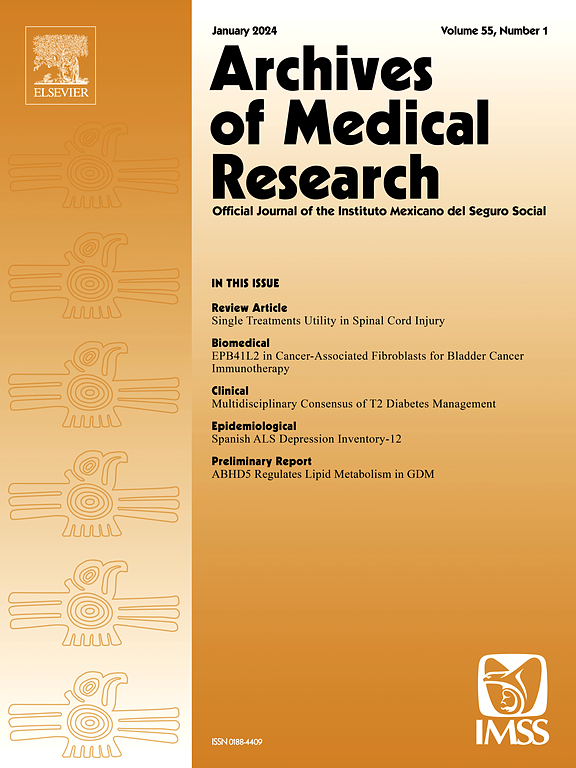墨西哥北部结直肠癌侵袭性增加的模式:2018年至2023年的多中心回顾性队列
IF 3.4
3区 医学
Q1 MEDICINE, RESEARCH & EXPERIMENTAL
引用次数: 0
摘要
结直肠癌(CRC)是全球第三大流行癌症,也是癌症相关死亡的第二大原因。早发性结直肠癌通常更具侵袭性,并且呈上升趋势。在墨西哥,2022年确诊病例为16082例;然而,流行病学数据仍然有限,特别是在红肉消费量高、筛查依从性低的北部地区。本研究旨在确定墨西哥东北部奇瓦瓦州的区域CRC趋势。方法对2018 - 2023年美国奇瓦瓦市两个中心的结直肠癌病例进行回顾性队列研究。从医学和病理记录中获得人口统计学、肿瘤位置、分期和基因检测(KRAS、NRAS和BRAF)的数据。分析采用描述性统计、t检验和χ2检验(p≤0.05),并采用移动平均分析评估年度趋势。结果451例结直肠癌患者平均年龄为60±12岁,男性占57.8%。三分之二的患者表现为晚期疾病(III/IV)。≤49岁的患者近端肿瘤和晚期诊断的患病率较高,尤其是IVc期。超过一半的转移病例缺乏基因分析。50岁以下和70岁以上患者的临床分期较高,各年龄组呈u型趋势(p=0.6)。结论:50岁以下晚期结直肠癌患者比例高,再加上缺乏基因检测,突出了本地区的两个关键问题:疾病侵袭性和获得适当护理的机会有限。这些发现强调了在墨西哥北部等高风险地区进行有针对性的研究和改进公共卫生战略的必要性。本文章由计算机程序翻译,如有差异,请以英文原文为准。
A Pattern of Increased Aggressiveness for Colorectal Cancer in Northern Mexico: A Multicenter Retrospective Cohort From 2018 to 2023
Background
Colorectal cancer (CRC) is the third most prevalent cancer worldwide and the second leading cause of cancer-related deaths. Early-onset CRC is often more aggressive and is on the rise. In Mexico, 16,082 cases were diagnosed in 2022; however, epidemiological data remain limited—especially in northern regions where red meat consumption is high and screening adherence is low. This study aims to identify regional CRC trends in Chihuahua, a northeastern Mexican state.
Methods
A retrospective cohort study of CRC cases from 2018 to 2023 was conducted at two centers in Chihuahua City. Data on demographics, tumor location, stage, and genetic testing (KRAS, NRAS, and BRAF) were obtained from medical and pathology records. Analysis included descriptive statistics, t-tests and χ2 tests (p≤0.05), and a moving average analysis to assess annual trends.
Results
Among 451 CRC cases, the mean age was 60 ± 12 years and 57.8% were male. Two-thirds presented with advanced-stage disease (III/IV). Patients ≤49 years showed a high prevalence of proximal tumors and advanced-stage diagnoses, especially stage IVc. Over half of metastatic cases lacked genetic analysis. There was a U-shaped trend among age groups, with patients under 50 and over 70 being diagnosed at higher clinical stages (p=0.6).
Conclusions
The high proportion of advanced-stage CRC in patients under 50, combined with the lack of genetic testing, highlights two key issues in our region: aggressive disease and limited access to adequate care. These findings underscore the need for targeted research and improved public health strategies in high-risk areas such as northern Mexico.
求助全文
通过发布文献求助,成功后即可免费获取论文全文。
去求助
来源期刊

Archives of Medical Research
医学-医学:研究与实验
CiteScore
12.50
自引率
0.00%
发文量
84
审稿时长
28 days
期刊介绍:
Archives of Medical Research serves as a platform for publishing original peer-reviewed medical research, aiming to bridge gaps created by medical specialization. The journal covers three main categories - biomedical, clinical, and epidemiological contributions, along with review articles and preliminary communications. With an international scope, it presents the study of diseases from diverse perspectives, offering the medical community original investigations ranging from molecular biology to clinical epidemiology in a single publication.
 求助内容:
求助内容: 应助结果提醒方式:
应助结果提醒方式:


